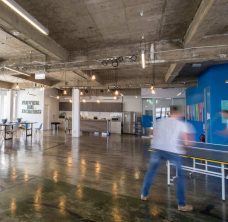
Although office and commercial interiors are considered to be low-risk when it comes to OHS (Occupation Health and Safety) in an office environment, they still, however, contain numerous health and safety hazards.
As such, they require careful planning during the commercial interior design phase and monitoring to reduce the risk of incidents, preventing serious health issues in the office environment.
Choose an Office Fitout Interior Designer with Experience Designing with OHS in Mind
Similar to any workplace, Melbourne’s commercial and office fit-outs also need to have their hazards identified, with risk assessments carried out in order to effectively implement control measures used to reduce the likelihood of workplace incidents occurring. IN2 SPACE Interior Design and Project Management have two decades of experience in commercial interior design.
Workplace Risks and Safety Resources for Your Office
Providing first aid in accordance with Work Health and Safety Regulation (WH&S) will ensure resources are available to assist workers should the need arise.
Here are some great resources and complimentary guides for you to use in your workplace.
Some common workplace hazards in the office include:
- poor or inadequate lighting, resulting in eye strain,
- ergonomic hazards such as repetitive movement, inefficient workplace design/uncomfortable workstation height, or poor body positioning,
- extremes in temperature, due to air conditioning and poor office acclimatization,
- manual handling hazards such as lifting, carrying, or moving heavy boxes and equipment (this also includes sustained or awkward working postures),
- slip, trip and fall hazards due to loose bathroom tiles, untidy computer cables, or frayed carpeting,
- electrical hazards such as faulty kitchen appliances, loose power sockets, or frayed cabling,
- highly contagious illnesses spread by sick employees, such as colds and the flu,
- fire hazards such as damaged power cords, blocked walkways and fire escapes, or large quantities of highly combustible materials (paper, furniture, adhesives, and aerosols),
- chemical hazards such as cleaning products and highly corrosive disinfectant chemicals,
- stress hazards such as lack of work variety, excessive time pressures/deadlines, or workplace bullying.
All the aforementioned health and safety hazards – once identified – need to be risk-assessed and controlled. This is achieved by determining the likelihood of each risk causing a serious injury and, based on that assessment, establishing control measures and adequate safety procedures to reduce or eliminate those risks.
After implementing the control measures, it’s essential that they are monitored and regularly reviewed to ensure they remain effective, and that employees in every office and commercial fit-out stay safe.
